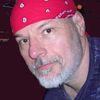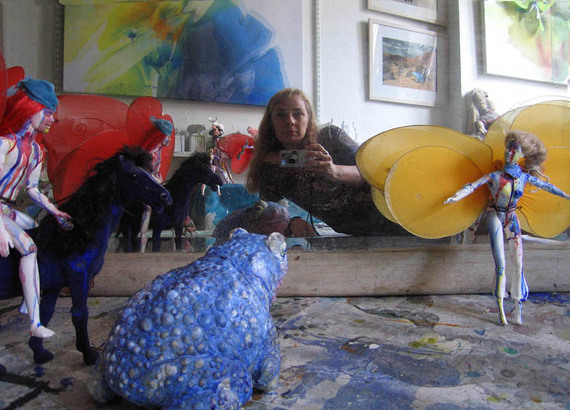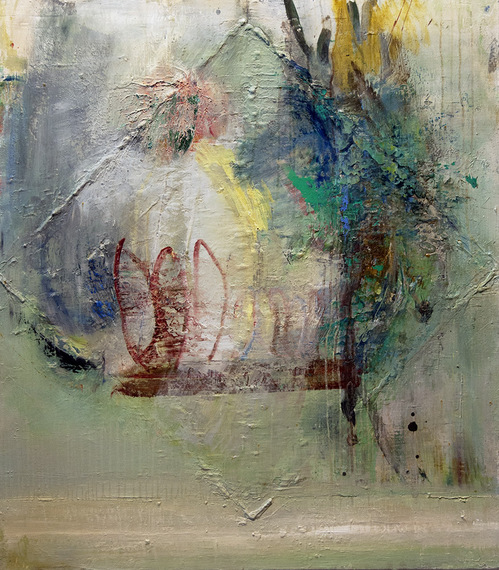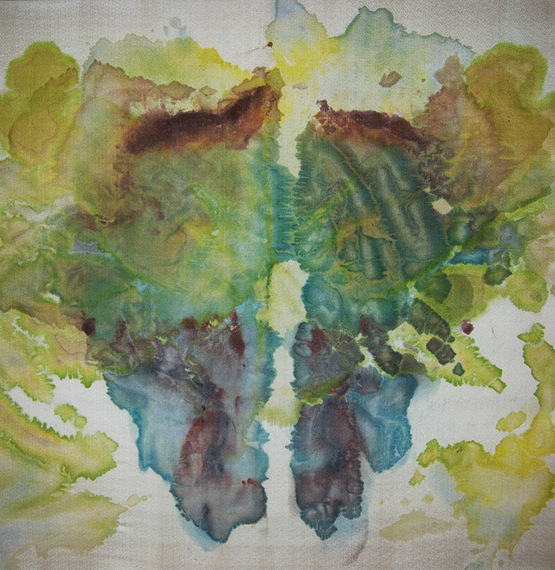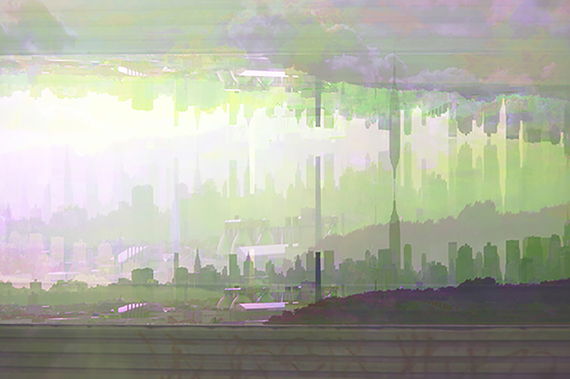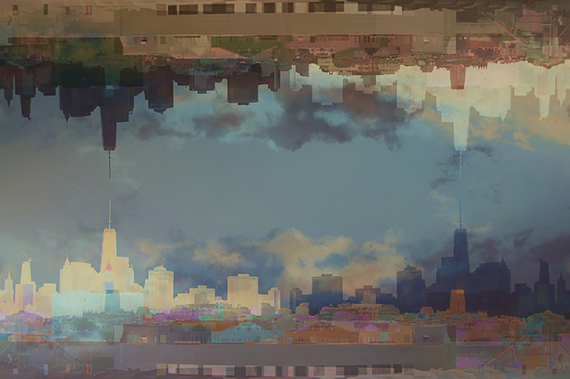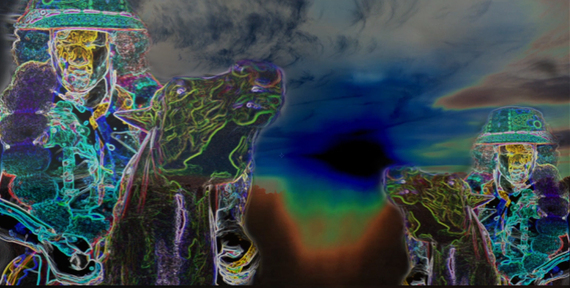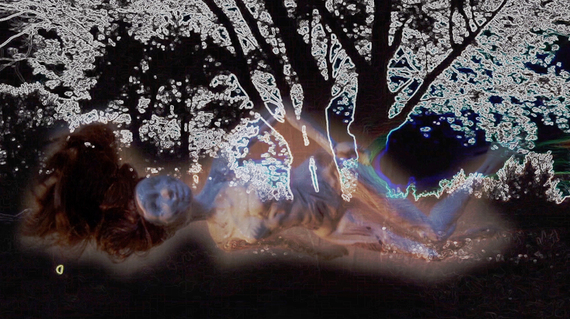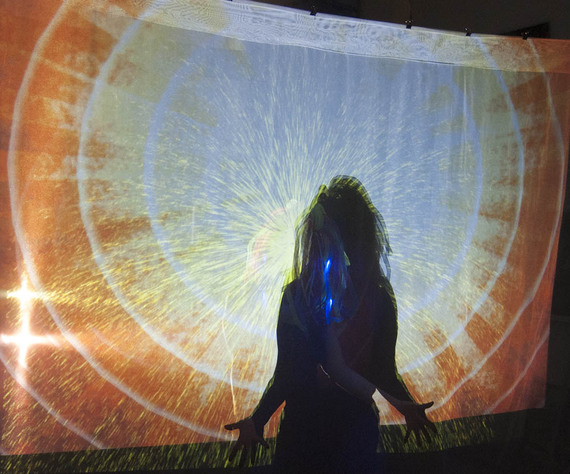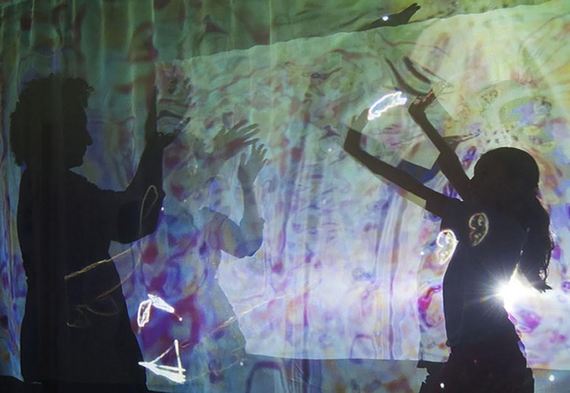Jean Wilkinson has built a substantive career as a contemporary artist, never falling prey to sensation or shock value. Her approach has been quite progressive for decades, having focused on a number of issues including gender, race and identity as it relates to perception. Over time, her reshaped reality has become a series of staged events acted out by her Painted People in the form of paintings, photo-based digital collages and multimedia installations. Throughout, the constant is Wilkinson's way of conveying a waking dream-like mode that expands our collective thought processes while keeping the possibilities enhanced and open and the path free and clear.
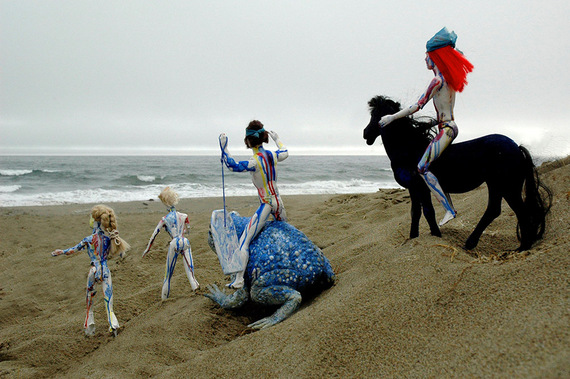
On the Beach (from the Western Walkabout Series), digital photo by Andrew Keeley Yonda in collaboration with Jeanne Wilkinson, 2006, size variable
The following is a recent conversation I had with Wilkinson that leads us to the heart of her message.
DDL: In thinking about your upcoming three day screening of one of your epic multi-media works in late March at Five Myles Gallery, I wonder how difficult it was for you to make the change from somewhat traditional painting to new media.
JW: It was a long process; kind of an evolution, I guess, of one thing leading to the next. Some of it was very difficult, but I always felt as if the work was leading me and not vice versa. I was developing a series of Abstract Expressionist oil paintings when some health issues began to arise - respiratory sensitivity to various oil mediums - and I switched to acrylic paints. If you're a painter, you know what a momentously big deal this is.
Once I made that change, the nature of acrylic and its endless flexibility led me to other changes: staining, layering and exploring translucencies. Then I began to add found objects to the paintings, stuff I'd pick up on the street and in thrift stores, and then the found objects became the art in collages and assemblages. At one point a pile of naked Barbie and Ken dolls entered my studio, can't remember how or why, but they called out to me and I responded by covering them with white gesso like you would a piece of stretched canvas, and then "drip-painting" them in a Mondrian palette of red, yellow and blue. It kind of just happened. Then I found the toad and painted him blue, and also the Horse with No Name, HWNN.
That was the birth of the Painted People. My son, photographer Andrew Keeley Yonda, took a series of pictures of them on our trip from the Rocky Mountains to the Pacific Ocean, their first vision quest in real time and space. My sons introduced me to Photoshop, which shook my world, and the Painted People began to go on some amazing virtual adventures. Then "still" imagery started to seem too restrictive, so I started using Adobe After Effects, an animation program, which was a lot more difficult than Photoshop, incredibly arcane, a whole new tech-oriented language to learn. This is not a natural milieu for me and I spent many hours and days finding internet tutorials to answer whatever frustrating, hair-pulling, hour-eating problem I had, and while I always found the answers, it was an uphill battle all the way. And then there's the projectors, speakers, media players, cameras, theatrical props - I found myself in a world far, far away from putting paint on a canvas. But the work kept propelling me down this path - the very first video I made ended up being shown at BAM as part of a film festival sponsored by the Brooklyn Arts Council, so that was very encouraging.
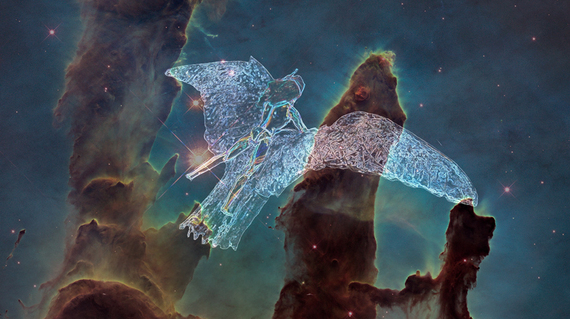
Jeanne Wilkinson, Red Over the Eagle Nebula, 2016, digital collage, size variable (Hubble imagery used with permission)
DDL: I fully understand your frustrations but it was well worth the hard work and dedication based on the results. There is a post-apocalyptic feel to some of the imagery, especially The Painted People in Long Island City. On the other hand, these same images are quite stunning and look a lot like scenes from a beautifully crafted film. As you mention, I know you make video and work a lot with manipulated still photographs - have you ever thought of creating a graphic novel based on the travels of the Painted People? That's a whole other genre that will bring in a very different set of problems but the work does lend itself to a longer narrative. I know the videos create a long narrative but a graphic novel would reach a very different audience that is just as in tune with your contemporary sensibilities. Also, a graphic novel adds a certain level of intimacy because it's basically one-to-one and there is a bit of voyeurism in the way the subjects are photographed.
JW: That's an intriguing suggestion. I have been asked before about writing a story line for the Painted People, as the imagery does suggest a narrative. But up to this point I haven't wanted to pin them down to a specific story; I've wanted them to be more mysterious than, say, super heroes with certain powers that define who they are and what they do. I have written fiction before - I've done an illustrated novella about a group of animals who take on end-of-the-world issues involving two competing realms called "WEarth" and "Rect-World." But for some reason the Painted People have eluded me as to getting their story down. Maybe I have to spend some time mulling this over, see what takes shape.
DDL: Before we get to your video installation at Five Myles Gallery I wonder if you could give me some insight into your City Symmetry series. They're quite moving, even haunting at times and very different from your Symmetry Paintings of 2000, when you were experimenting with staining and layering of acrylic paints. With City Symmetry, you offer something of a contemporary combination of Constructivist and Futurist photography. It works well because the architectural geometry, discordant color and thick atmosphere gives the work a subtle feeling of disorientation or vertigo - portraying the big city as a sort of overbearing external, albeit magnificent organism.
JW: Funny, I was in the Museum of Modern Art yesterday staring at Boccioni's States of Mind trilogy, thinking how he and the other Futurists would have embraced the computer. There was a time when I, unlike the Futurists and Constructivists, thought that the city was destructive, having basically usurped nature with its massive forms and geometries. But now I see it differently - while the city is definitely overbearing, by concentrating population in smaller areas, it can actually help preserve other ecosystems...now if we could just get rid of suburban sprawl and transform city buildings into vertical farms...well, in any case, I'm no longer anti-city. I often see it as beautiful with its strong forms and tenebristic dark-light dramas.
Beauty is in fact an important concept to me - I believe that it's critical to human health and happiness, and that as symmetrical beings, we recognize symmetrical relationships as beautiful. This has not been a popular stance in the art world, and the paintings that you mentioned from 2000 received a scathing critical response as hopelessly antiquated, disappointing, etc. Which didn't bother me too much, at least the antiquated part because I'm fascinated with forms like Greek temples whose aspect ratios reflect the mystical "rectangle of the whirling squares."
I read The Elements of Dynamic Symmetry by Jay Hambidge while a grad student at Pratt Institute, about "natural design" and how temple floor-plans are related to growth patterns of plants like sunflowers, and these ideas continue to engage me. With City Symmetries the city itself becomes a realm that is, as you say, a magnificent organism, full of not perfect symmetries, which are sterile, but dynamic, ever-changing relationships. Hmmm, I think a City Symmetry film will have to be next, to make these changes come to life...
DDL: Yes, a good lead in to your installation at Five Myles Gallery. The way I understand it, your plan is to have two screens that are rear projected and suspended from the ceiling of the gallery. As a result, your audience can walk through the projected video and become part of the art, perhaps acting out their conscious thoughts or impressions. From what I've seen of the narrative intentions of this piece, I see a journey, a waking-dream as mentioned earlier, whereby one of your painted people soars through veils of atmospheres and images accompanied, and perhaps prodded by your musical score. It all feels like a lucid, albeit fantastical mix of somewhat advanced computer-based representations with lots of more basic animation techniques like frame-by-frame action or movement throughout. I like that mix, it gives the whole thing a much-needed human presence - like a child play-acting - only the child is ages old and very wise. Am I anywhere near your intention?
JW: Yes, two projectors are placed on opposite sides of the room and directed onto two translucent scrims hung halfway between them in parallel rows, close enough for people to walk between them in what I call the Cloud Tunnel. At Five Myles, one image stream will be of the Painted People flying and floating through the darkness, the other image stream will be of the worlds in which they fly: sometimes "real" places and sometimes abstract environments of color, movement and light. The imagery overlaps and interacts on the scrims and walls in an ever-changing loop, and, as you say, people can become part of the art by walking, dancing, casting shadows and creating movement, which then becomes another layer of imagery when I photograph them.
I actually don't do frame-by-frame or stop-motion animation - I don't have the patience! My technique is pretty random, really, or maybe "intuitive" would be a better word. I take photos and short clips constantly of the city, country, subway, streets, parks, air travel, strangers, family members, whatever, and store them in a folder on my computer. Then when an idea for a video starts to form, I mull over the data and transfer the chosen files into After Effects where I begin to experiment with various filters and effects. I also incorporate my paintings and drawings into the imagery, along with the artwork and music of family and friends. So each video is also a kind of journal of my life, albeit a very abstract, non-linear journal.
I very much like your description of my artwork as a waking-dream, and as the play-acting of an ages-old child. I think the meaning of life can be found in the open-endedness and generosity of play, as if we're here on earth to experience and appreciate just how amazing it all is, and to be open to life as children are. Then again, I think we're currently surrounded by a lot of grown-ups demonstrating the worst traits of children, like toddlers grabbing and laying waste to all they touch...so the idea of a tempering wisdom is all important.
The video installation is going to be similar to this video link for The Sun and the Horn Solstice Event.
I use two projectors with 2 translucent scrims set up between them in parallel rows. The imagery is projected from each side of the room and meets in the middle on the two scrims and there is a continual changing interaction between the image streams. You can kind of see how it works on my website if you visit the following link for Something Something with Fish.
In this latest video, I'm using recent pictures taken from the Hubble satellite to show the Painted People leaving the confines of earth to travel into a cosmic realm where they seem to fit right in. Maybe this is part of the narrative you suggested earlier: that they're fed up with the status of life on earth, and how beauty itself is leaving along with all the disappearing species and their degraded environments, so the Painted People are themselves taking off for better climes...an option we humans unfortunately don't have.
